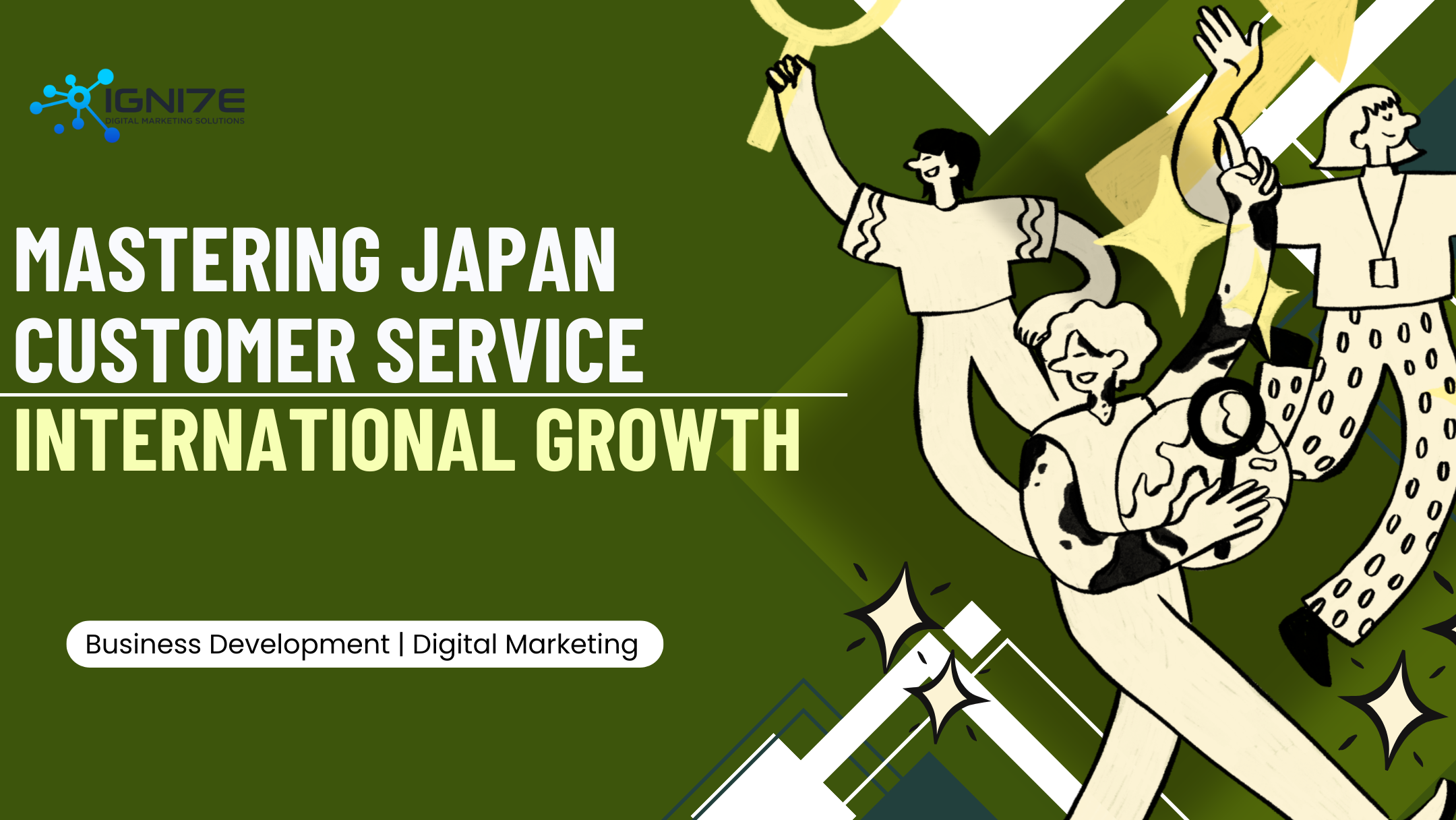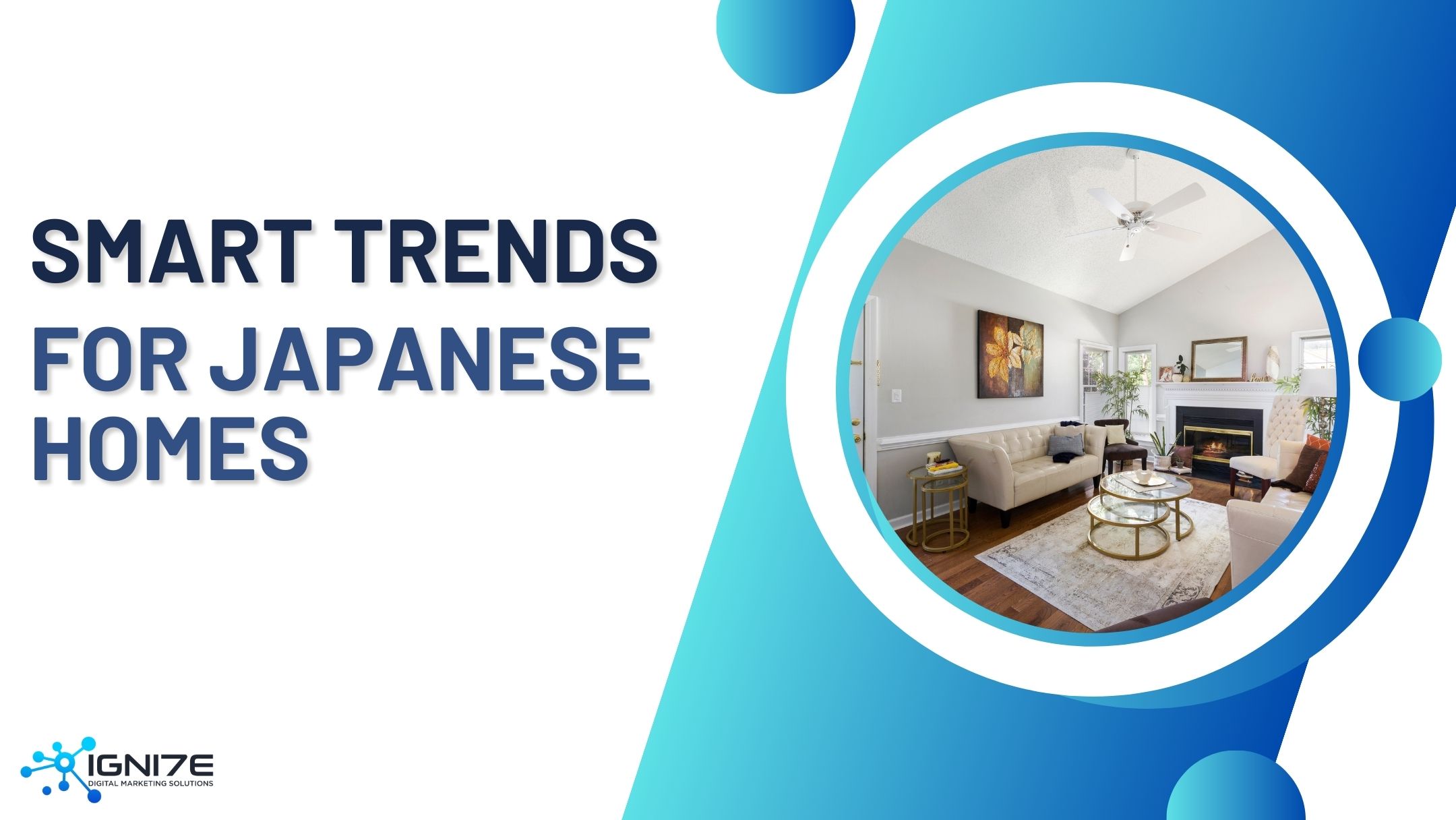Unveiling Japan's Unique Content Marketing Secrets

At first glance, content marketing in Japan may seem no different from the global standard. After all, the fundamentals remain the same: provide valuable, relevant content to engage your target audience, build trust, and drive business outcomes. In this sense, content marketing is a universal strategy practiced from San Francisco to Singapore.
But once you look closer, the execution in Japan reveals itself as uniquely nuanced, shaped by cultural values, consumer expectations, and distinct communication preferences.
In Japan, content is not just content. It’s a reflection of trust, tradition, and meticulous attention to detail. Messaging tends to be subtle, design preferences lean toward minimalism, and storytelling often serves a higher purpose than product promotion. Platforms also differ—LINE, Note.com, and Ameblo dominate where Western marketers might expect LinkedIn or Medium.
So yes, content marketing is fundamentally the same everywhere. But how it's done—and how it lands with the audience—can differ dramatically in Japan.
Universal Content Marketing Principles (Japan is No Exception)
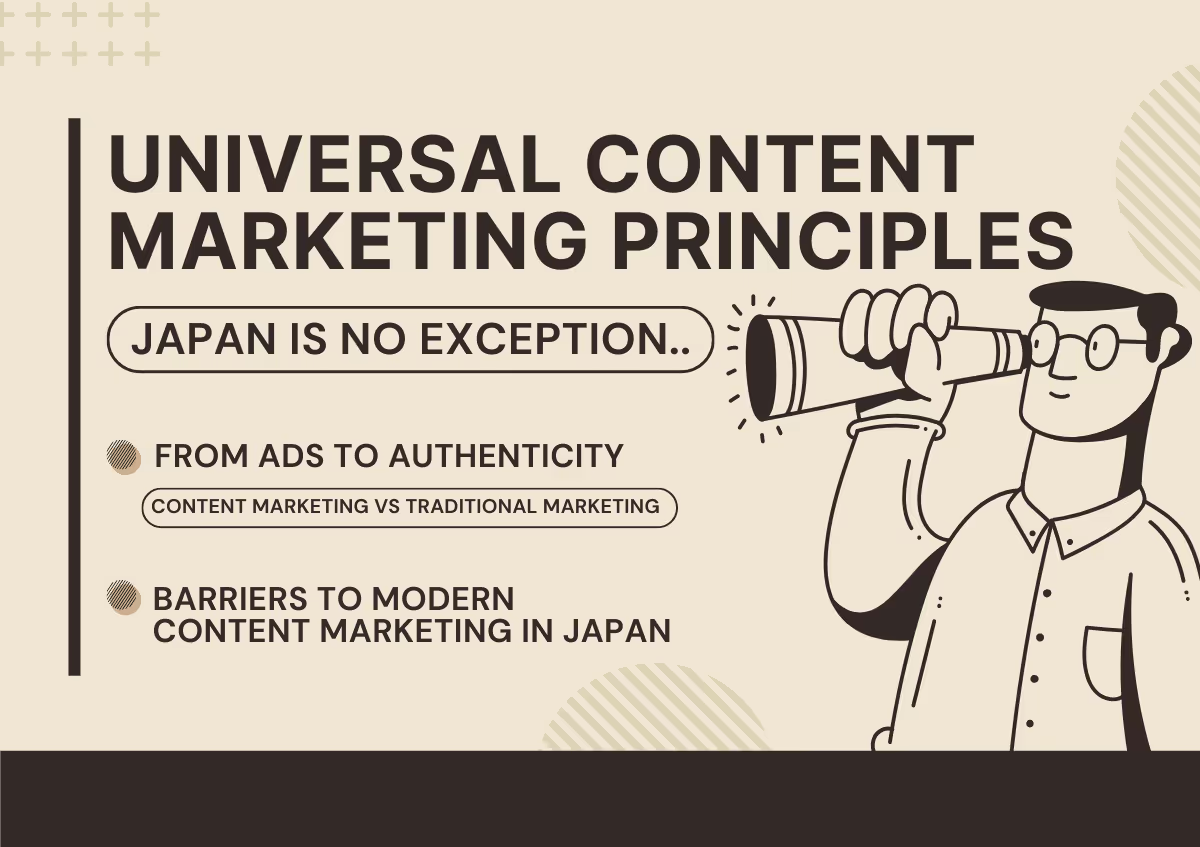
At its core, content marketing is the strategic process of creating and distributing valuable, relevant, and consistent content to attract and retain a clearly defined audience. The goal? To drive profitable customer action, not through overt promotion, but by earning attention and trust over time.
In every market around the world, successful content marketing does a few things very well:
- Educates or entertains
- Builds long-term brand trust
- Reflects the audience’s values and needs
- Encourages engagement and loyalty
And in this regard, Japan is no exception.
From Ads to Authenticity: Content Marketing vs. Traditional Marketing
To understand content marketing in Japan, it helps to see how it diverges from traditional marketing methods still prevalent in the local business environment.
Traditional Marketing in Japan
Traditional marketing in Japan, like elsewhere, includes methods such as:
- TV commercials
- Newspaper and magazine ads
- Posters and billboards
- Brochures and catalogs
These methods aim for broad exposure and immediate recognition. They’re effective in generating quick visibility but often feel one-sided or impersonal, particularly to modern audiences who expect two-way interaction and authenticity.
The Shift to Content Marketing
Content marketing, on the other hand, is centered on value. It prioritizes audience engagement, relevance, and trust-building over sales pitches. And in Japan, this takes a uniquely patient and polished form:
- Messages are conveyed subtly through stories.
- Visual design reflects harmony, elegance, and often seasonality.
- The goal is long-term loyalty, not a one-time purchase.
This is especially significant in Japanese culture, where relationships—whether business or personal—are cultivated slowly and with great care.
A Digital Turning Point
The emergence of social platforms like LINE, YouTube, and Note.com has further widened the gap between traditional and content-driven marketing. Audiences now expect brands to meet them with engaging stories, real-time updates, and shareable content. Companies that still rely solely on top-down, interruptive messaging risk being tuned out completely.
Barriers to Modern Content Marketing in Japan
Despite its potential, content marketing in Japan faces several unique challenges that international companies must navigate.
- Seniority-Driven Decision Making
In many Japanese companies, marketing decisions are made by senior leadership, who may be more familiar with traditional channels and hesitant to invest in newer digital approaches. This generational gap can slow down digital transformation and innovation.
- Risk Aversion and Cultural Conservatism
Japanese business culture often values consistency and predictability. Change is introduced gradually and cautiously. While this ensures stability, it also makes rapid adaptation—something content marketing usually requires—more difficult.
- High Standards and Perfectionism
Japanese consumers expect high-quality content. That means:
- Impeccable visuals
- Culturally appropriate language
- Accurate, useful information
The bar for excellence is high, which can make content production more resource-intensive and slow.
- Digital Transition Struggles
Many companies are still in the early stages of shifting from traditional to digital marketing. This often requires not just new tools, but a fundamental change in mindset and organizational structure.
How Content Marketing in Japan Stands Out
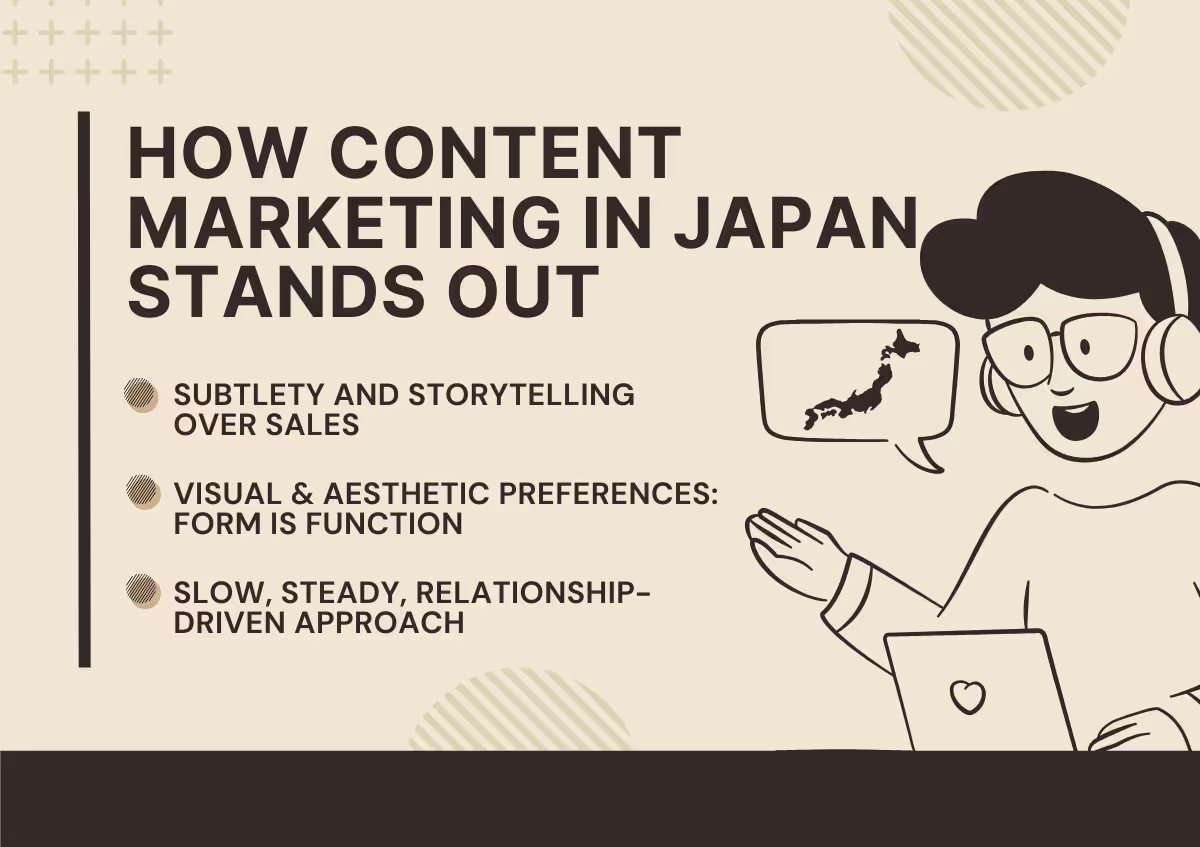
Japanese content marketing doesn’t aim to reinvent the wheel, but it certainly polishes it differently. While the foundational principles align with global practices, the “how” in Japan is shaped by deep cultural norms, subtlety in communication, and an unwavering focus on long-term trust. Let’s explore three defining traits that distinguish Japan’s content marketing landscape from that of other countries.
Subtlety and Storytelling Over Sales
“Say Less, Mean More” Communication in Japan
Unlike the Western style of messaging, which often prizes bold headlines and call-to-action-driven language like “Buy Now” or “Limited Time Offer,” Japanese content marketing leans heavily on indirect communication. The emphasis is not on shouting for attention, but gently earning it.
Culturally, Japan values “kuuki o yomu” (reading the air)—the social art of understanding unspoken messages and emotional context. This directly impacts marketing content. Instead of leading with benefits or offers, successful Japanese brands:
- Embed product value within narratives.
- Use emotional symbolism rather than overt persuasion.
- Highlight values such as tradition, harmony, and craftsmanship.
Storytelling That Honors the Audience
Narratives in Japanese marketing often resemble a cinematic experience—slow-building, reflective, and rich in cultural references. Consider Shiseido’s video campaigns: they often feature minimal product placement, instead focusing on aesthetic themes of self-care, seasonal change, or generational beauty ideals. The message isn’t “Buy this foundation,” but rather “This is how beauty lives through time.”
This style resonates deeply because Japanese audiences do not want to be “sold to”—they want to be respected and emotionally moved.
Why This Matters for International Brands
If you translate Western marketing copy directly into Japanese without cultural adaptation, your message may feel tone-deaf or pushy.Brands entering the Japanese market must:
- Localize messaging with nuance.
- Use layered metaphors (nature, seasons, tradition).
- Understand that in Japan, what’s not said can be more powerful than what is.
Visual & Aesthetic Preferences: Form Is Function
Minimalism with a Message
Japanese visual culture is built on centuries-old aesthetics like wabi-sabi (beauty in imperfection) and ma (negative space or timing). In marketing, this translates into content that:
- Avoids clutter and “loud” visuals.
- Uses ample white space.
- Aligns visuals with seasonal or cultural elements.
Even fast-moving consumer brands tend to embrace clean, harmonious design. Where a U.S. landing page may use bold color contrast and animated pop-ups, a Japanese equivalent often leans on subtle gradients, understated icons, and calm layouts that encourage careful reading.
Seasonal Sensitivity: Timing Is Visual
Japan has a deep cultural appreciation for the changing seasons, and successful brands incorporate this rhythm into their visual storytelling. It’s not uncommon for websites, social posts, or even packaging to change monthly—or even weekly—to reflect current seasons, festivals, or weather.
For example:
- Spring brings cherry blossoms (sakura), symbolic of renewal and fleeting beauty.
- Autumn leans into koyo (fall leaves)—often symbolizing reflection and change.
Shiseido, again, excels in this regard. Its product launches and visual branding often align with seasonal colors, traditions, and nature imagery, reflecting a cultural understanding far more profound than design trends.
Case in Point: JR East
JR East doesn’t just promote train tickets. Through video, social media, and digital campaigns, they celebrate the journey itself, highlighting local festivals, scenic routes, and hidden gems. Their content often reflects seasonal imagery, conveying a sense of nostalgia, warmth, and national pride.
This approach creates an emotional connection to travel, not just a functional transaction.
Slow, Steady, Relationship-Driven Approach
Why Speed Doesn't Sell in Japan
One of the most common missteps international companies make in Japan is trying to move too fast. Aggressive funnels, fast-lane conversion copy, and urgency-based tactics don’t always land well with Japanese consumers. Here’s why:
- Trust must be earned gradually.
- Reputation outweighs pricing or discounts.
- Risk aversion is high; customers do their research.
In Japan, a product isn’t just being judged—it’s being quietly observed over time. Brands must patiently show their commitment to quality, reliability, and consistency before consumers are willing to invest.
This dynamic mirrors Japanese business practices, where building rapport precedes transactions, and deals are often made over long-term discussions rather than aggressive pitches.
User-Centered Content Strategy in Practice
At the heart of this slow-burn model is a user-centered content creation strategy. That means:
- Deep understanding of user intent and behavior.
- Delivering content that solves specific problems or adds educational value.
- Maintaining a consistent tone and voice of empathy and service.
Successful Japanese content:
- Doesn’t just speak to the customer—it walks with them through the buyer journey.
- Is data-informed but human-first.
- Evolves constantly based on feedback, season, and market rhythm.
Patience = Performance
Think of Japanese content marketing like cultivating a bonsai tree. It’s not about speed—it’s about precision, care, and timing. It takes longer to build momentum, but once that trust is established, the loyalty can be far deeper than in faster-moving Western markets.
Key Takeaways for Global Marketers
Key Platforms for Japanese Content Marketing (And How They Differ)
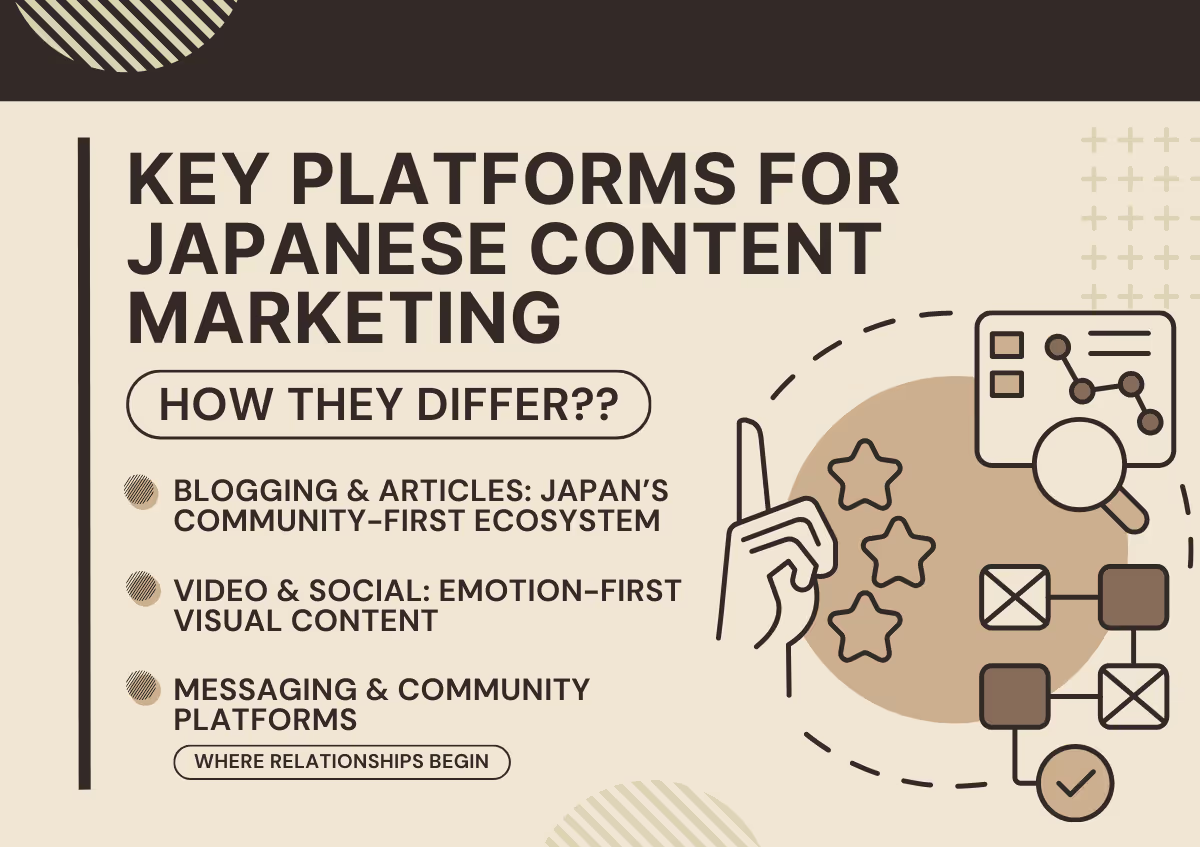
Understanding where your content lives is just as important as the content itself, especially in Japan. While global marketers may assume that platforms like Medium, Substack, or LinkedIn articles dominate the content space, the Japanese digital ecosystem operates quite differently.
Japan’s content platforms are rooted in community, subtle expression, and localized behaviors. Instead of polished professional publishing, many platforms feel more grassroots, personal, and conversational. Below, we break down the core channels used in Japan—alongside how they compare to Western equivalents—and why these differences matter.
Blogging & Articles: Japan’s Community-First Ecosystem
Japan: Note.com, Ameblo, Livedoor Blog
- Note.com – Publishing for Passion and Profit
Note.com is Japan’s closest equivalent to Medium but with a stronger creator-driven and community-focused foundation. It blends personal blogging with professional publishing, allowing users to share:
- Articles
- Essays
- Podcasts
- Videos
- Visual journals
Unlike Medium, Note allows direct monetization, meaning users can sell premium content, set up memberships, or receive support from fans.
Used by:
Independent creators, startups, writers, small brands, and corporate media arms can collaborate via Note Pro.
Why it matters:
Note.com prioritizes authenticity and quality, and its C2C orientation gives brands a space to speak as individuals, not faceless corporations. For foreign companies, it’s an ideal platform to localize thought leadership and build trust through storytelling, interviews, and opinion pieces.
- Ameblo – Japan’s OG Blog-Meets-Social Platform
Ameblo (Ameba Blog) is more than just a blogging site—it’s a full-fledged community hub. Operated by CyberAgent, it’s especially popular among:
- Mothers (ages 30–50)
- Lifestyle bloggers
- Celebrities
- Hobbyists
With its friendly interface and low entry barrier, it acts as both a digital diary and an entertainment portal, thanks to the massive volume of celebrity bloggers and its gamified social features.
Features include:
- Reader comments & community replies
- Integration with Ameba Pigg (a virtual avatar world)
- Trendy, social-first content themes (parenting, food, wellness)
Used by:
B2C brands, influencers, entertainment, beauty, and lifestyle sectors.
Why it matters:
Ameblo thrives on intimacy and relatability. Content here is often less polished, more emotional, and intensely interactive. Unlike Western professional blogs, the focus is on personality over authority. Foreign brands can partner with influential bloggers or sponsor lifestyle content to connect with specific demographics.
- Livedoor Blog – Freedom, Longevity, and Mass Reach
Owned by LINE Corporation, Livedoor Blog is one of Japan’s oldest and most versatile platforms. It’s home to everything from:
- Personal musings
- Political commentary
- Tech and gaming news
- Humor and 5chan-style “matome” (curated summary) blogs
With no paid tiers since 2015 and an emphasis on user freedom, Livedoor Blog hosts an enormous variety of content.
Features:
- Mobile blogging app
- Built-in SEO tools
- Simultaneous posting to the Livedoor app
- Group blogging capabilities
Used by:
Hobbyists, indie creators, bloggers who want flexibility without censorship.
Why it matters:
For brands, Livedoor is useful not as a publishing platform per se, but as a monitoring tool. It helps track user sentiment, niche trends, and grassroots dialogue, critical for understanding what resonates before crafting your own content.
Western Comparison: Medium, Substack, LinkedIn Articles
- Medium: More academic, structured, and SEO-oriented. Often lacks the social, community-driven layer found in Japanese platforms.
- Substack: Gated newsletters work in Western markets, but paid subscriptions are less prevalent in Japan, where most content is expected to be free or micro-monetized.
- LinkedIn Articles: While LinkedIn is growing in Japan, it’s not yet widely used for content discovery or B2C visibility.
Key Difference:
Japanese platforms center around community interaction, emotional storytelling, and local culture, whereas Western ones focus more on professional polish and authority.
Video & Social: Emotion-First Visual Content
In Japan, visual content reigns supreme—but it’s not about flashy gimmicks or over-the-top virality. Japanese audiences gravitate toward video content that feels authentic, emotionally resonant, and culturally in tune. Whether it’s through long-form storytelling or bite-sized entertainment, the goal is to connect, not interrupt.
Here’s how Japan’s dominant video and social platforms are shaping content marketing.
YouTube: The Bedrock of Video Storytelling
YouTube remains the cornerstone of video content in Japan. While global marketers are familiar with its power, the way it’s used in Japan has unique nuances:
- Longer watch times: Japanese users often prefer slow-paced, in-depth videos over rapid-fire edits.
- Subtitled content is the norm: Even for native Japanese speakers, captions are expected—it’s considered courteous and accessible.
- Narrative-driven structure: Product placements or promotions are often embedded within a story arc, rather than called out explicitly.
- Trust over trendiness: Viewers value sincerity and knowledge-sharing, making explainer videos, tutorials, and behind-the-scenes storytelling especially effective.
Best for: Beauty, travel, lifestyle, tech, B2B explainers, corporate storytelling
Avoid aggressive intros or over-branding. Focus on visuals that reflect harmony, expertise, or emotional depth. Think: documentary tone, not commercial pitch.
TikTok: Fast-Paced, Trend-Driven, Culturally Sharp
TikTok has seen explosive growth in Japan, particularly among Gen Z and Millennials. But Japanese TikTok culture differs notably from its Western counterpart.
- Trendy—but not crass: Even the most viral content maintains a sense of tasteful creativity. Humor is often quirky, situational, or self-deprecating rather than outrageous or confrontational.
- Influencers play a central role: Micro- and mid-tier influencers (called “TikTokers” locally) often set trends rather than chase them.
- Music & aesthetics matter: Seasonal themes, nostalgic tracks, or kawaii visuals are popular—there’s a cultural appreciation for refinement even in short-form formats.
- Challenge culture is huge: Brands often partner with creators to launch hashtag challenges or brand filters that play into Japan’s love of gamified content.
Best for: Fashion, food, entertainment, skincare, consumer tech, youth brands
Localize your content—not just the captions, but the humor, references, and visuals. Global TikTok trends don’t always translate. Collaborate with Japanese creators who understand the pulse of the platform and the expectations of the local audience.
Twitter (X): Still a Social Powerhouse
Twitter (now X) continues to dominate in Japan, far more than in many Western countries. It functions as:
- A real-time conversation hub
- A news aggregator
- A customer service platform
- A community space for fandoms, gaming, and subcultures
Japanese Twitter users are highly active, with Japan ranking among the highest for tweet volume globally. What makes Twitter special in Japan?
- Retweets over replies: Sharing is more common than public debate.
- Image-first posts: Tweets with images, videos, or illustrations get significantly more engagement.
- Polite engagement norms: Even snarky accounts stay within bounds of indirectness and respect.
Best for: Gaming, tech, publishing, entertainment, pop culture brands
Consistency matters more than virality. Use Twitter for community-building, announcements, and low-pressure brand engagement. Campaign hashtags work well, especially if tied to seasons, fandoms, or cultural events.
Messaging & Community Platforms: Where Relationships Begin
LINE: Japan’s Super-App for Content and Community
LINE is far more than a messaging platform. It’s a whole content ecosystem, combining:
- Newsfeeds
- E-commerce
- Influencer channels
- Branded content
- Live video
- Loyalty card integration
For marketers:
- Brands can operate official LINE accounts to send personalized content.
- LINE stickers and mini apps can act as soft marketing.
- Consumers often expect to follow brands via LINE.
Platform power: LINE enables highly targeted content delivery through push notifications, personalized journeys, and 1:1 communication—capabilities that Western messaging apps (WhatsApp, Messenger) lack.
Western Comparison:
Creating Content that Connects in Japan
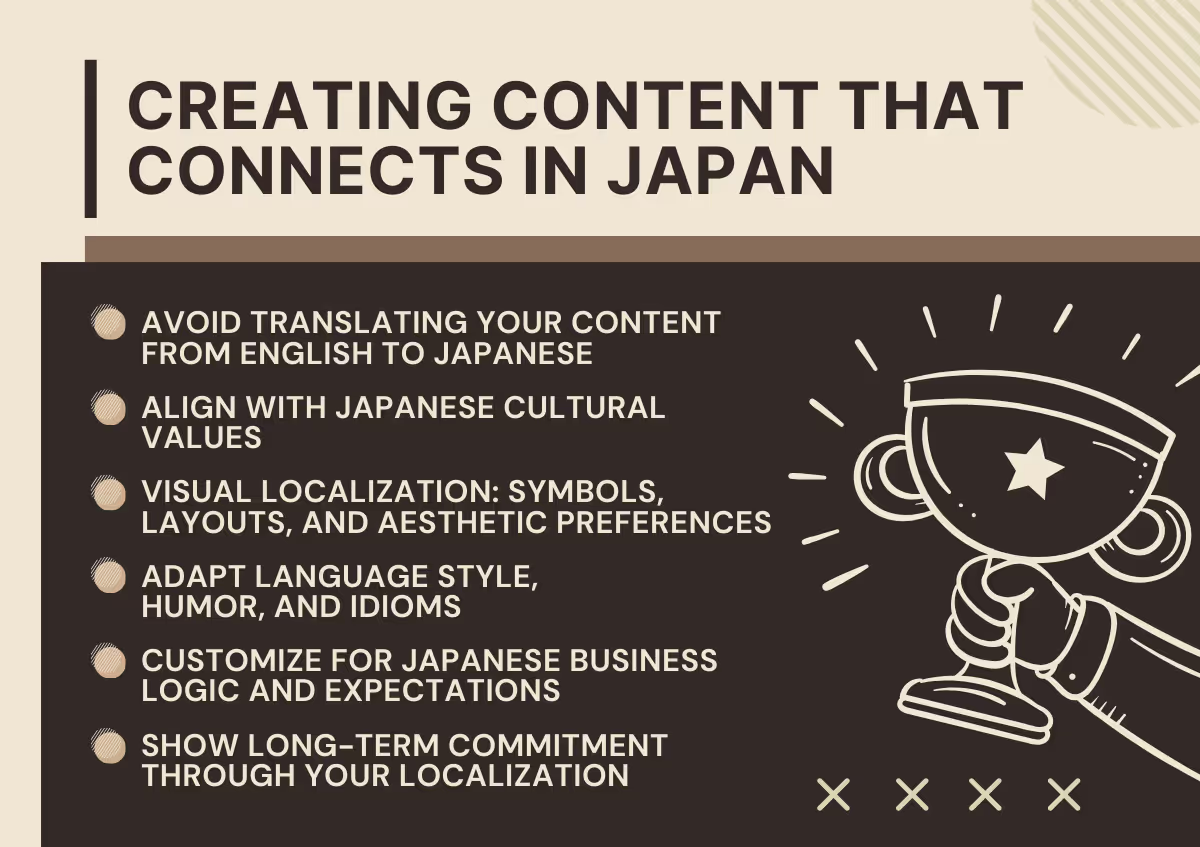
Localization in Japan is not an afterthought—it's a prerequisite. While many international companies approach localization as a line item in their marketing checklist, in Japan, it's the key to earning attention, trust, and ultimately, long-term brand loyalty.
To create content that truly connects, companies must go beyond direct translation and embrace full-spectrum localization—one that considers tone, social norms, cultural symbols, business etiquette, and visual language.
Avoid Translating Your Content from English to Japanese
Translation is about language. Localization is about meaning. For Japanese audiences—particularly in the B2B space—this distinction can make or break your content’s effectiveness.
Why Direct Translation Isn’t Enough
It’s tempting to take existing English content—like a product brochure, case study, or white paper—and run it through a translation service or even an in-house bilingual staff member. But this method risks:
- Misaligned tone: What feels energetic and compelling in English may feel brash or careless in Japanese.
- Inaccessible idioms: Common English expressions rarely carry over effectively (e.g., “think outside the box” or “game-changer”).
- Lack of cultural or regulatory relevance: Western case studies or pain points may not reflect Japanese business concerns.
For example:
“AI automation cuts costs and accelerates transformation.”
“AI technologies support continuous operational efficiency, addressing long-term workforce challenges.”
The latter appeals to Japan’s cautious, pragmatic, and harmony-oriented approach to innovation.
Align with Japanese Cultural Values
Localization must align not just with linguistic norms, but with the emotional and social fabric of Japanese communication. This includes respect for:
- Formality and structure
- Consensus-based decision-making
- Politeness and indirect expression
- Community and harmony over individualism
Why Direct Translation Isn’t Enough
Tip: Instead of commanding action, gently guide the reader. Use language such as:
“ご検討いただけますと幸いです” (We would be grateful for your consideration)
“~についてご紹介します” (We would like to introduce…)
This level of humility is expected and appreciated, especially in formal content.
Visual Localization: Symbols, Layouts, and Aesthetic Preferences
Content isn’t just read—it’s seen. The design and visual presentation of your content must reflect Japanese sensibilities, which often prioritize:
- Clean, minimalist layouts
- Balanced white space
- Subdued color palettes
- Seasonally relevant or nature-inspired imagery
Why Direct Translation Isn’t Enough
Colors, icons, and even typefaces have different emotional associations in Japan:
- Red: Celebration (e.g., New Year), but also correction/alerts depending on context.
- White: Purity and elegance, often seen in ceremonial branding.
- Circle (〇): Signifies correctness or affirmation (more common than checkmarks).
- Cross (✗): Denotes wrong answers or disapproval (best avoided in promotions).
Example: A Western infographic might use a big red “X” to mark a problem area. In Japan, a light gray arrow or an “under construction” icon would feel more tactful.
Adapt Language Style, Humor, and Idioms
Idioms Don't Translate (Literally or Figuratively)
English expressions like:
- “Boil the ocean”
- “Low-hanging fruit”
- “Bleeding-edge”
…may confuse or alienate Japanese readers. Japanese business communication is rooted in clarity and professionalism, so any metaphors must be either:
- Culturally adapted, or
- Removed in favor of direct explanations.
Humor Is Delicate
Humor in Japanese content marketing tends to be:
- Situational (not sarcastic or ironic)
- Cultural (based on shared understanding, like seasonal jokes)
- Subtle (using tone and visual cues more than wordplay)
If your English copy includes jokes or humorous analogies, assess whether they:
- Reinforce your core message
- Can be adapted to Japanese media and sensibilities
- Risk being misunderstood or inappropriate
Sometimes, replacing humor with warmth and approachability is better—a tone Japanese audiences trust.
Customize for Japanese Business Logic and Expectations
Structure, Flow, and Authority
In Japanese B2B content, how you say something is just as important as what you say. Expect readers to value:
- Step-by-step logic
- Hierarchical structure
- Professional polish
Use:
- Executive summaries at the beginning
- Clear section headers
- Closing remarks that re-emphasize respect, commitment, or partnership
Example: A case study aimed at Japanese executives should not start with a bold claim like “We doubled their sales in 60 days.” Instead:
“After introducing our platform, the client saw measurable improvements in operational efficiency, which over time contributed to significant gains.”
This respects the Japanese preference for credibility over hype.
Show Long-Term Commitment Through Your Localization
Localization is more than a technique—it’s a signal. It shows the high quality of customer service and, it tells Japanese customers:
“We’re not just entering your market—we’re here to understand you.”
By going beyond translation, you show:
- Cultural sensitivity
- Business etiquette fluency
- Respect for your audience’s intelligence and time
Ways to demonstrate commitment:
- Launch your campaign during a culturally appropriate season (e.g., fiscal new year in April)
- Offer Japan-specific documentation and support
- Highlight your understanding of local challenges (e.g., aging workforce, compliance standards)
- Make use of note.com, LINE, and other Japan-first platforms to publish content
Localization done well leads to deeper engagement, higher trust, and more effective long-term relationships in the Japanese market.
Emerging Trends in Japanese Content Marketing
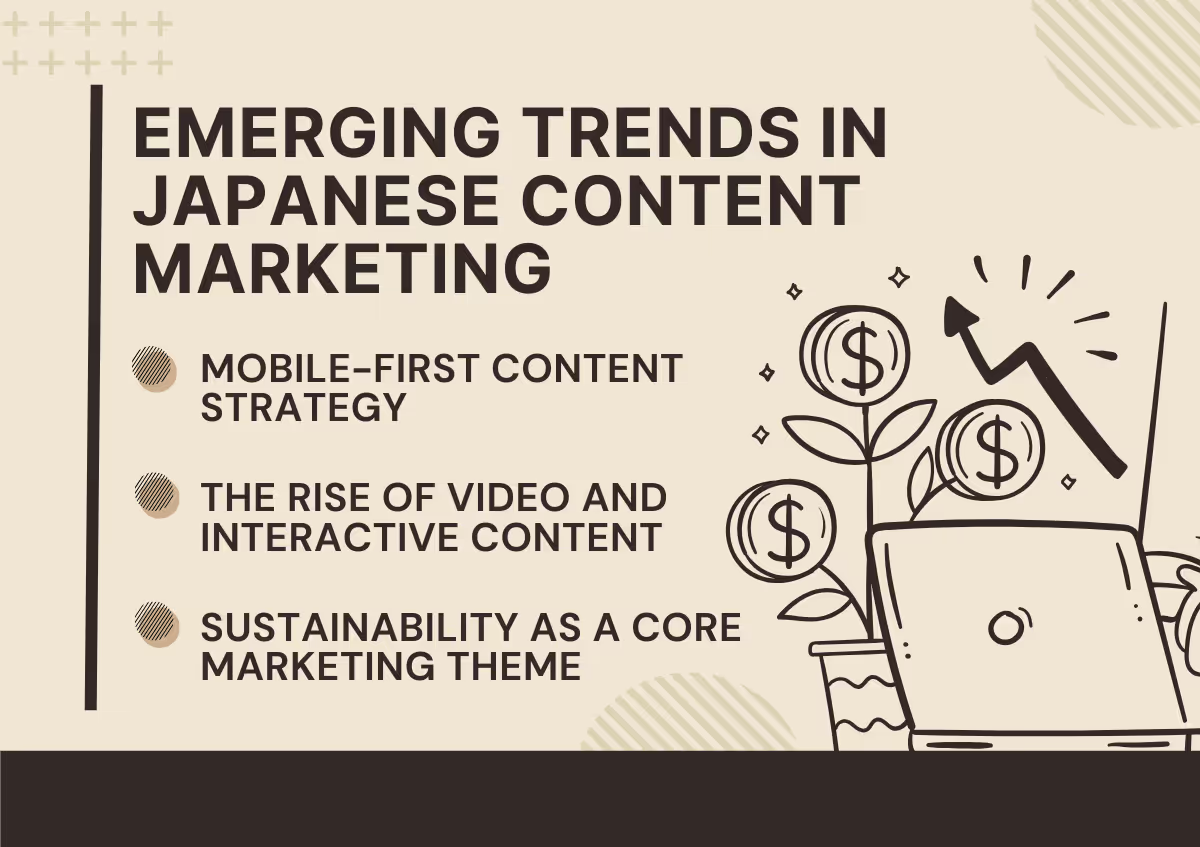
Japanese content marketing continues to evolve in step with technological innovation and shifting consumer values. While cultural sensitivity and emotional nuance remain essential, new formats and priorities are reshaping how brands connect with their audiences.
Below are three significant trends redefining content strategies in Japan today—and what they mean for international marketers looking to stay relevant and resonant.
Mobile-First Content Strategy
Smartphones are now the primary device for consuming content in Japan. With high-speed connectivity and widespread mobile usage, users expect seamless digital experiences while commuting, shopping, or relaxing at home.
To meet this expectation, content must be:
- Fast-loading on all devices
- Optimized for vertical scrolling
- Clear and concise, especially for on-the-go consumption
Japanese users often engage in short bursts, so content that delivers immediate value—like short blogs, tap-through image carousels, or quick videos—tends to perform well. Visual clarity and simple navigation are critical; overloaded pages or cluttered layouts risk immediate bounce.
This trend affects everything from website design to social media strategy. Brands must think mobile-first not only in technical execution but also in how stories are structured and how quickly they capture attention.
The Rise of Video and Interactive Content
Visual storytelling has always had cultural weight in Japan, but recent years have seen a sharp rise in demand for dynamic, video-based formats, especially among Gen Z and Millennials. Japanese consumers don’t just watch content; they expect it to feel meaningful, beautifully presented, and often, emotionally grounded.
Video content that performs well in Japan typically features:
- Slow pacing and clear narration
- Subtitled dialogue or captions, even for native speakers
- Themes of emotion, tradition, or everyday life
Interactive elements are also gaining ground. From live streams with audience chat to virtual try-ons and 360-degree video tours, Japanese consumers are embracing content that lets them explore, engage, or participate. Even B2B companies are beginning to adopt formats like webinars with Q&A, interactive case studies, and demo walk-throughs.
While global trends often push for speed and surprise, Japanese audiences respond more deeply to content that feels crafted, measured in tone, and generous in detail.
Sustainability as a Core Marketing Theme
Sustainability has shifted from a trend to a core value in the eyes of many Japanese consumers. Environmental consciousness, social responsibility, and ethical business practices are increasingly influencing purchasing decisions, especially among younger generations.
For brands, this means sustainability should no longer sit in a silo. It should be embedded into:
- Product messaging (e.g. eco-friendly packaging or sourcing)
- Brand storytelling (e.g. company culture, long-term initiatives)
- Community engagement (e.g. local partnerships, transparency reports)
But in Japan, subtlety and sincerity are essential. Japanese consumers are highly attuned to inauthentic or overplayed messaging. Rather than bold claims, brands should offer:
- Proof over promises
- Behind-the-scenes content showing ongoing efforts
- Localized narratives that connect sustainability with cultural practices, such as mottainai (the spirit of not wasting)
Sustainability content that aligns with traditional Japanese values tends to generate not just engagement, but respect.
Conclusion: Speak to the Heart of Japanese Consumers
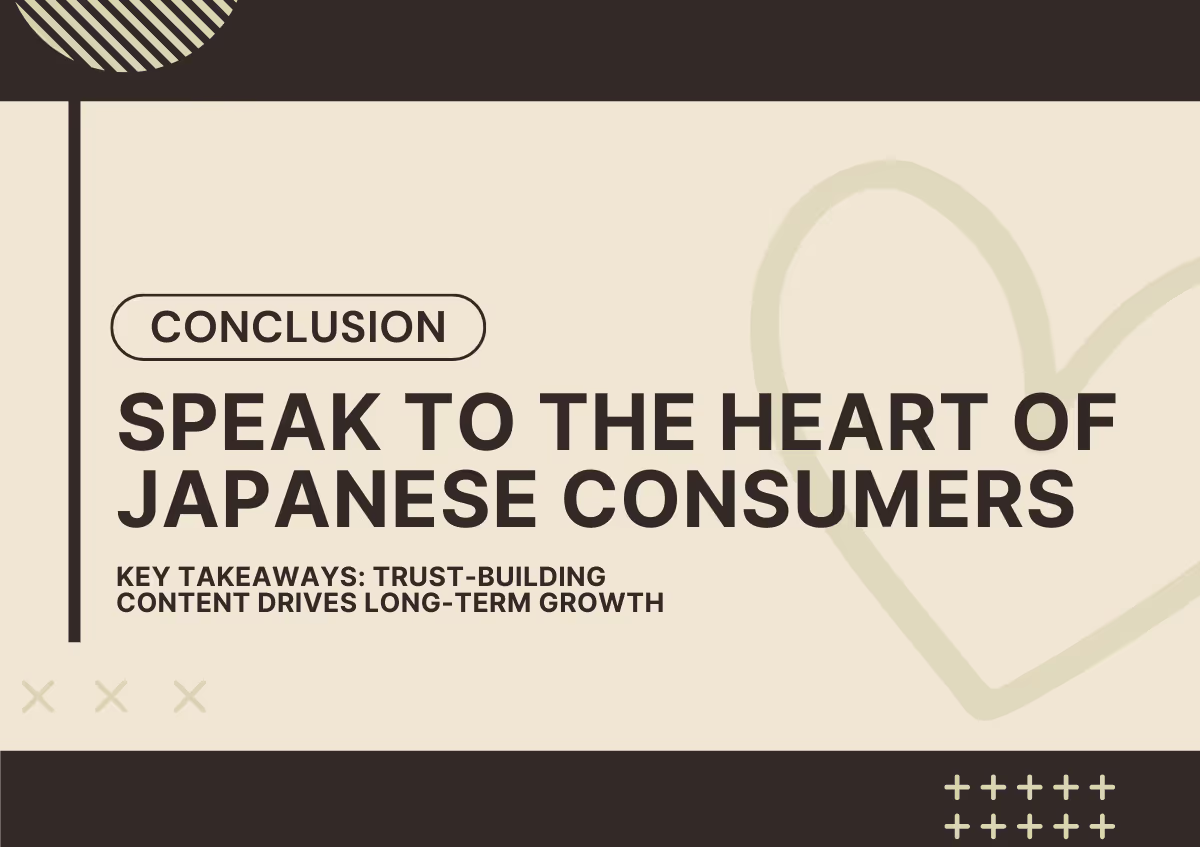
Content marketing in Japan is not a copy-paste effort from global strategies. While the foundational principles are the same—creating value, building trust, and fostering loyalty—the pathway is distinct. The Japanese audience expects brands to listen first, communicate subtly, and engage with cultural fluency.
Whether you’re publishing a blog, launching a video series, or planning a new campaign, remember: in Japan, long-term resonance wins over short-term noise. Brands that succeed here are those that invest in localization, respect the cultural context, and embrace Japan’s visual and emotional depth.
Key Takeaways: Trust-Building Content Drives Long-Term Growth
Ready to Ignite Your Content Strategy in Japan?

At IGNITE, we don’t just translate campaigns—we transform them.
As your on-the-ground digital marketing partner in Japan, we offer:
- Culturally-attuned localization, not just literal translations
- Results-driven strategies tailored to Japanese platforms and personas
- A seamless extension of your team, based right here in Osaka
From SEO-optimized blogs to emotionally resonant videos, we know how to speak to Japanese audiences in a way that drives not just clicks, but trust, engagement, and brand love.
Let us help you open Japan.
Contact IGNITE to start building content that connects, converts, and compels in Japan.





